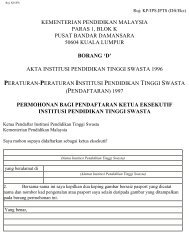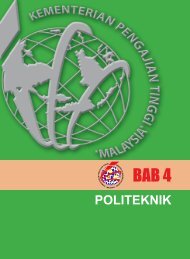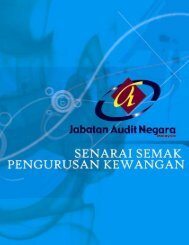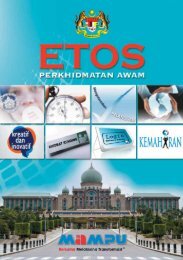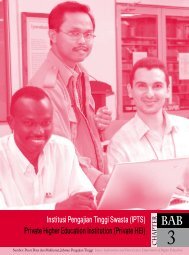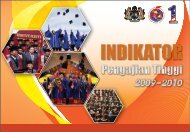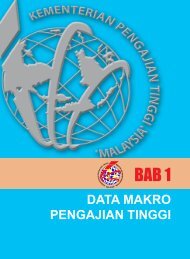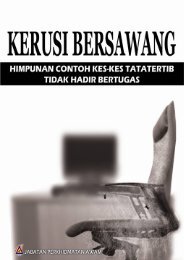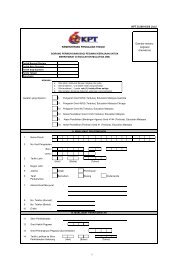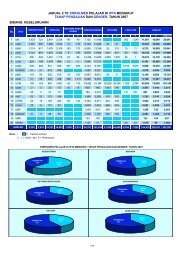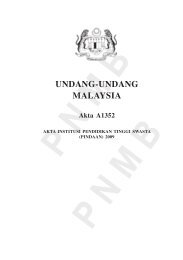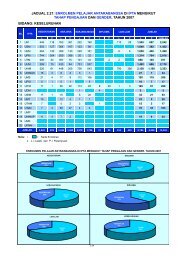Introduction Archery can be defined as a non-contact, static sport ...
Introduction Archery can be defined as a non-contact, static sport ...
Introduction Archery can be defined as a non-contact, static sport ...
Create successful ePaper yourself
Turn your PDF publications into a flip-book with our unique Google optimized e-Paper software.
Movement, Health & Exercise, 1(1), 49-60, 2012<strong>Introduction</strong><strong>Archery</strong> <strong>can</strong> <strong>be</strong> <strong>defined</strong> <strong>as</strong> a <strong>non</strong>-<strong>contact</strong>, <strong>static</strong> <strong>sport</strong> that requires its archers topossess muscular strength, upper body endurance and high levels of stability.These performance variables are required specifically at the trunk region,shoulder girdle, and for both arms to ensure shooting accuracy, and score of theshoots which eventually determine the winner (Ertan, 2009; Soylu, Ertan, &Korkusuz, 2006). Besides strength and endurance, postural stability is anothercrucial variable in determining the outcome of every shot. An archer’s skill isevidenced in the ability to shoot the arrow to the specific target within a specifictime. To achieve this, athletes need to minimize their movements in each step orph<strong>as</strong>e to avoid unnecessary movements which <strong>can</strong> reduce stability, thus,minimizing the chances of hitting the centre target. An archer’s movements must<strong>be</strong> <strong>as</strong> precise <strong>as</strong> possible, coping f<strong>as</strong>t with postural instability (Kuo, Chi, Yu &Tsung, 2005; Ertan, 2009; Ertan, Kentel, Tumer, & Korkusuz, 2003; Kuo & Chi,2005).In precision aiming t<strong>as</strong>ks, postural stability tends to <strong>be</strong> the most importantvariable that needs to <strong>be</strong> controlled in order to achieve the highest performance.Having a high level of postural stability when aiming incre<strong>as</strong>es the aimingstability of the archer. Aiming stability ensures uninterrupted flight trajectory tothe target and this situation gives impact to the performance outcome (Kuo etal., 2005). Therefore, archers, regardless of their performance level, are affectedby postural sway (Era, Konttinen, Mehto, Saarela, & Lyytinen, 1996; Ball, Best& Wrigley, 2003; Mo<strong>non</strong>en, Konttinen, Viit<strong>as</strong>alo, & Era, 2007).The most important ph<strong>as</strong>e in determining the success of every shot in archery isthe aiming and rele<strong>as</strong>ing ph<strong>as</strong>e, followed by the follow-through ph<strong>as</strong>e. Once thearcher h<strong>as</strong> <strong>be</strong>gun to draw the bow and starts aiming at the target, he or she tendsto maintain the posture of the arms and trunk, keeping it fixed to ensure that thearrow is properly aligned with the intended target. When postural movementshave <strong>be</strong>en minimized, the archer <strong>can</strong> e<strong>as</strong>ily focus on the target itself(Bal<strong>as</strong>ubramaniam, Riley, & Turvey, 2000). Stability of the shooting needs to <strong>be</strong>maintained at the highest level in order to obtain a good and small scoredeviation. One of the important subcomponents in maintaining shooting stabilityis aiming stability, which also appears to <strong>be</strong> the main factor that affects shootingperformance. Aiming stability is <strong>defined</strong> <strong>as</strong> the locus pattern of aiming and it isnoted that the expert archer’s aiming locus is much smaller in contr<strong>as</strong>t to<strong>be</strong>ginner archers (Ertan et al., 2003; Ertan, 2009; Kuo & Chi, 2005).Postural Sway and Aiming StabilityPosture <strong>can</strong> <strong>be</strong> <strong>defined</strong> <strong>as</strong> the geometric relationship <strong>be</strong>tween different bodysegments (Bal<strong>as</strong>ubramaniam & Wing, 2002). In other words, postureencomp<strong>as</strong>ses body joints angles. For example, the right arm wrist and elbow50
Postural Sway and Shooting Accuracyangles descri<strong>be</strong> the posture of string arm for right handed archers. Body postureserves two functions. Firstly, it serves <strong>as</strong> a standing position point of referencewherein posture works <strong>as</strong> antigravity and plays a major role in keeping bodybalance. The balancing function is affected by preventing falls throughmaintaining the centre of gravity within an individual (Fisher, 2010). As such, innormal standing positions, the postural control system’s main function is tointegrate the antigravity and balance functions of the body. Secondly, bodyposture functions <strong>as</strong> a reference framework for movements. It provides the head,torso, hip, legs and other body segments a framework for moving towards anyspecific target or performing any movement (Fisher, 2010).In order to achieve the highest point in archery, every shot must hit the centre ornear the centre of the target. Archers need to control their movements at everyph<strong>as</strong>e to affect precise aims and rele<strong>as</strong>e arrows at accurate sighting points.Accurate sighting points <strong>can</strong> <strong>be</strong> achieved by maintaining or maximizing aimingstability. To sustain aiming stability at the highest level, archers need tomaximise postural stability whilst controlling every other <strong>as</strong>pect in their aimingprior to the shoot. Earlier research illustrated that by incre<strong>as</strong>ing aiming andequipment stability, the shooting scores are also incre<strong>as</strong>ed correspondingly.Besides equipment stability, postural stability also plays a major role indetermining performance. Archers or shooters who are able to control theirpostural stability have a more stable platform in aiming and this incre<strong>as</strong>esperformance <strong>as</strong> compared to those who <strong>can</strong>not control postural balance(Mo<strong>non</strong>en et al., 2007).Archer's expertise also plays a major role in determining whether they are ableto cope with postural stability. Era et al. (1996) suggest expert athletes are ableto rapidly stabilize postural stability compared to <strong>be</strong>ginner and novice athletes.Moreover, these athletes are able to control postural stability right to the end.This appears to <strong>be</strong> acquired through training and competitive experiences, thusenabling them to manipulate their posture in order to achieve positive outcomes.The present study seeks to determine the possible causal relationship <strong>be</strong>tweenpostural sway and shooting performance.Materials and MethodsParticipantsTwenty-one (n = 21) skilled archers from Peninsular Malaysia participatedvoluntarily in this study. The skilled archers comprised of both genders andwere aged <strong>be</strong>tween 13 to 25 years. They are considered skilled due to theirqualification scores of 1150 upon 1440 full FITA score in either national orinternational rank competitions.51
Movement, Health & Exercise, 1(1), 49-60, 2012InstrumentationTo quantify postural sway value, Zephyr Bio-Harness devices (model PSMResearch version 1.5, single transmitter and receiver) were used instead of forceplatform (reliability 0.841 - 0.941). The transmitter w<strong>as</strong> set to transmit live datafeed <strong>as</strong> opposed to hard drive recording. Subsequently, live data weretransformed into graphs and figures in 10-second lengths per draw with 15frames per second drawing feed. A laptop (model Toshiba Satellite L510, 3Gbram capacity, 4.60Ghz processing capabilities) w<strong>as</strong> used to compute allequations with software from Zephyr (version 2.3.0.5) that enabled comparisonof multiple data and capturing real time data transmission. A digital videorecorder (model Sony Handycam DCR-SR68E) w<strong>as</strong> used for video recordingpurposes. Every participant’s shooting w<strong>as</strong> recorded for further analysis.ProceduresA shooting area w<strong>as</strong> constructed at the respective testing sites. The shooting areaprepared included two target butts and target stands that were situated 30 metersfrom the shooting line for official target practice and official data collection.Multiple 10-meter targets were set up for warming up prior to target practice andthe official data collection period.Figure 1: Shooting Area for Data CollectionParticipants were briefed on the purpose of the study and the proceduresinvolved. Letters of consent were signed a week <strong>be</strong>fore to waive any accidentaloccurrences during the test that are not related with the test protocols. The studyw<strong>as</strong> also approved by the UiTM research ethical committee (reference no: 600-RMI [5/16]). Prior to data collection, ample warming up time w<strong>as</strong> given to theparticipants for short distance targets. This warming up session l<strong>as</strong>ted 15minutes. Participants were required to o<strong>be</strong>y the shooting regulations which limitlong end shooting in a four-minute time period. For this time limit, usuallyarchers need to shoot a minimum of six arrows where<strong>as</strong> for the warming upsession, participants are allowed to practice <strong>as</strong> many shoots <strong>as</strong> possible within52
Postural Sway and Shooting Accuracythe time limit. Shooting speed usually correlates with the expertise level. Expertor skilled archers are usually able to shoot 10 to 12 arrows in the time limitprovided. For a 15 minute-warming up session, three ends of shooting were ableto <strong>be</strong> conducted. Warming up involved either rhythmic or f<strong>as</strong>t shootingtechniques at 10-meter targets without any target face. This w<strong>as</strong> important toincre<strong>as</strong>e body temperature and promote blood flow to the limbs in order toreduce the possibility of injury and prevent muscle soreness.After thorough familiarization with the test conditions, participants were given12 arrows for official target practice. They were to shoot at the 30-meter targetbut no score and postural sway value were recorded. Twelve arrows were shot intwo ends within a four-minute time period for each respective end. Participantspaced their own shooting time according to their expertise level. Arrows thatwere shot after the time limit ended were considered <strong>as</strong> misses with zero (0)marks awarded.Participants were <strong>as</strong>ked to complete 12 official shots at the 30-meter target.Shooting cue w<strong>as</strong> given by either the researcher or researcher <strong>as</strong>sistant. Thetarget face used w<strong>as</strong> the official FITA 80 cm 30-meter target. This target faceconsists of five colours and 11-point rings that reflect the score ranging fromone to ten with the center ring marked <strong>as</strong> “X”. This ring brings a score of ten andis considered <strong>as</strong> highly accurate compared to the actual outer ten rings.Figure 2: Target Face Diagram (Score Ring)Participants were required to use their own bow and arrows for performanceme<strong>as</strong>urement purposes. Standardized prepared equipments by the researcherwould inhibit participant’s own shooting style and shooting performance would<strong>be</strong> affected due to the difference in ergonomics and equipment characteristics.<strong>Archery</strong> equipment is personalized and archers need a familiarization periodwith new equipment settings to enable them to exercise good control whilstincre<strong>as</strong>ing their shooting technique consistency and persistency.53
Movement, Health & Exercise, 1(1), 49-60, 2012Each tested participants w<strong>as</strong> equipped with a Zephyr Bio-Harness device, wor<strong>non</strong> the xyphoid process under the sternum. The device <strong>be</strong>lt or garment is placedunder the participant’s shirt. The pilot study carried out showed that the devicewould not interfere with the bow string path and would therefore not affect theshooting characteristics. The participants were allowed to shoot with theirpreferred position but stance techniques were limited <strong>as</strong> they were required touse the straight stance. After putting on the Bio-Harness, the participants were<strong>as</strong>ked to stand still with full equipment on the shooting line for 10 seconds toobtain a standing-upright posture value. Subsequently, the participants shot anarrow each time they were given a start cue until they finished shooting all the12 arrows. Whenever the participants were in the stance ph<strong>as</strong>e, they were givena “start” command and the data w<strong>as</strong> collected by starting the recording of thelive data transmitted by the device. The transmitting of the real-time data w<strong>as</strong>stopped after the participants finished the rele<strong>as</strong>e and follow-through ph<strong>as</strong>es ofthe six arrows or end. All of the ph<strong>as</strong>es took about four to ten seconds dependingon the athletes’ expertise and level of performance. In this study, the subject’sperformance w<strong>as</strong> individually observed and w<strong>as</strong> digitally recorded.ResultsThe participants’ shooting performance w<strong>as</strong> me<strong>as</strong>ured by their shooting scoresfrom the twelve shots to the 30-meter target. The shooting scores ranged fromzero to bulls eye (X, or ten points, the highest mark). Zero point w<strong>as</strong> awarded ifthe participants missed the target face or the target, while the highest score w<strong>as</strong>given to the participant that hits bulls eye. Figure 3 depicted the scoredistribution <strong>be</strong>tween skilled and unskilled participants.Score Distribution for Skilled Archers10080604020016435230 1 2 4 4 678 69Miss 1 2 3 4 5 6 7 8 9 10 XSkilledFigure 3: Score Distribution <strong>be</strong>tween GroupsThe mean score for the skilled group w<strong>as</strong> 8.58 points. For this group, the highestscore w<strong>as</strong> nine points (31.0%) followed by 10 points (27.4%) and eight points(17.1%). Two percent from a total of five arrows that missed the targetconstitutes the lowest score for this group. The lowest percentage score obtainedby the skilled participant group w<strong>as</strong> four and five (1.6%). Data obtained from54
Postural Sway Value (0)Postural Sway and Shooting Accuracythe study illustrates variances in postural sway characteristics throughoutshooting performance. As shown in Table 1, the le<strong>as</strong>t sway recorded w<strong>as</strong> duringthe setup ph<strong>as</strong>e and the highest w<strong>as</strong> during the aiming ph<strong>as</strong>e. During the setupph<strong>as</strong>e, the sway w<strong>as</strong> positive which indicates the occurrence of swaying to theanterior while for the aiming and rele<strong>as</strong>e ph<strong>as</strong>e, negative reading w<strong>as</strong> recordedindicating posterior sway.Table 1: Postural Sway Value (Mean ± SD)Ph<strong>as</strong>e Postural Sway ( 0 )Ph<strong>as</strong>e 1 (Setup) 0.01 ± 7.532Ph<strong>as</strong>e 2 (Aiming) -1.56 ± 4.129Ph<strong>as</strong>e 3 (Rele<strong>as</strong>e) -0.71 ± 4.675Postural Sway Characteristics0.20-0.2-0.4-0.6-0.8-1-1.2-1.4-1.6-1.80.01Setup Aiming Rele<strong>as</strong>e-0.71-1.56SkilledFigure 4: Diagram of Postural Sway Characteristics through Ph<strong>as</strong>es55
Movement, Health & Exercise, 1(1), 49-60, 2012Multiple regression analysis w<strong>as</strong> applied to test the relationship <strong>be</strong>tweenpostural sway during shooting ph<strong>as</strong>es and shooting performance. Multipleregressions indicate that when body sway incre<strong>as</strong>ed, shooting performance willdecre<strong>as</strong>e.Table 2: Correlations <strong>be</strong>tween Variables with Shooting ScoreVariables Pearson Correlation p valuePosture 1 (Setup)Posture 2 (Aiming)Posture 3 (Rele<strong>as</strong>e)-0.221*-0.0210.248*0.0010.3670.001* Signifi<strong>can</strong>t level (p < 0.05)Table 2 shows the correlations and signifi<strong>can</strong>t value of variables whichcontributed to shooting score performance of Malaysian skilled archers. Thehighest correlations are portrayed by postural sway characteristics during therele<strong>as</strong>e ph<strong>as</strong>e with r value of 0.248 and reached a statistically signifi<strong>can</strong>t state at(p < 0.001). The second highest relationship w<strong>as</strong> documented by postural swaycharacteristics during the setup ph<strong>as</strong>e (r = -0.221) with a signifi<strong>can</strong>t value of(p < 0.001).Table 3: Coefficients <strong>be</strong>tween Variables with Score for Skilled GroupModel Standardized CoefficientsBetaPosture 1 (Setup)-0.174*Posture 2 (Aiming)-0.072Posture 3 (Rele<strong>as</strong>e)0.262** Signifi<strong>can</strong>t level (p < 0.05)p value0.0080.3090.001According to Table 3, postural sway during the rele<strong>as</strong>e ph<strong>as</strong>e contributes themost towards the model with standardized coefficients value of 0.262(p < 0.001) with 23.8 percent partial correlation of overall model correlation.This variable makes the strongest unique contribution to explain the shootingperformance of the skilled group compared to other variables, when the varianceexplained by all other variables in the model w<strong>as</strong> controlled. The second highestcontributor towards the model w<strong>as</strong> postural sway during the setup ph<strong>as</strong>e withstandardized coefficients of -0.174 (p = 0.008) with 16.7 percent partialcorrelation value. Regression analysis indicates that there is a signifi<strong>can</strong>t resultfor the relationship <strong>be</strong>tween the model with shooting performance (p < 0.001).These data suggest that the model contributes towards shooting performancecharacteristics, thus indicating that there exists a signifi<strong>can</strong>t relationship <strong>be</strong>tweenpostural sway across shooting ph<strong>as</strong>es with the performance of arrow shoots ofthe skilled Malaysian recurve archers.56
Postural Sway and Shooting AccuracyTable 4: Model Summary for Skilled GroupModel R Square Adjusted R SquarePosture 1, Posture 2, Posture 3 0.105 0.094Table 4 displays the R Squared and adjusted R square value. For this model, theR square value w<strong>as</strong> 0.105 which expresses a percentage of 10.5 per cent. Thismeans that this model explains the 10.5 per cent of the variance in skilled groupshooting performance. A coefficient test w<strong>as</strong> conducted afterwards in order toseek the variable that contributes the most towards the relationship <strong>be</strong>tween themodel and shooting performance.DiscussionThe goal of this study w<strong>as</strong> to determine whether postural sway affects shootingperformance whilst examining the ph<strong>as</strong>e which directly affects shootingperformance. Stuart and Atha’s (1990) study which compared archers fromdifferent skilled levels and also examined those within the same level ofperformance revealed that the differences <strong>be</strong>tween skilled levels were smallercompared to differences <strong>be</strong>tween each respective shooting ends within eachgroup. However, their research focused on movements of certain body partssuch <strong>as</strong> the head, string arm elbow and bow handle. Prior studies also focused onthe whole shooting process, while the current study examines the movements atthree different ph<strong>as</strong>es of shooting.The current study me<strong>as</strong>ures actual postural sway characteristics at outdoorshooting fields rather than in a controlled environment such <strong>as</strong> inside a test lab.This w<strong>as</strong> to ensure the testing environment closely resembles the actual shootingwith its surrounding ambiance, wind and weather conditions. Prior studies wereall lab-b<strong>as</strong>ed in an enclosed environment which did not resemble the actualenvironment. Additionally, the present study analysed multiple ph<strong>as</strong>es of theshooting process. P<strong>as</strong>t studies mostly focused on one ph<strong>as</strong>e wherein overall dataw<strong>as</strong> compared <strong>be</strong>tween groups. In this study, overall performance w<strong>as</strong> brokendown into three ph<strong>as</strong>es; i.e. the setup, aiming and rele<strong>as</strong>e ph<strong>as</strong>e. In so doing, theresearcher is able to determine the ph<strong>as</strong>e that most impacts shootingperformance rather than looking at it generally (Bal<strong>as</strong>ubramaniam, Riley, &Turvey, 2000; Era et al., 1996; Gautier, Thouvarecq, & Larue, 2008; Ke<strong>as</strong>t &Elliot, 1990; Miyamoto, 1994; Mo<strong>non</strong>en et al., 2007; Stuart & Atha, 1990).Vuillerme and Nougier (2004) noted that experts from different <strong>sport</strong>s do notdiffer in terms of postural sway during unpertur<strong>be</strong>d stance and during raiseddifficulties. This is <strong>be</strong>cause experts tend to incre<strong>as</strong>e their automatic ability ofcontrolling postural sway, an ability harnessed throughout years of training andtournaments. Prior studies suggest that cognitive mechanisms are dependent on57
Movement, Health & Exercise, 1(1), 49-60, 2012levels of expertise. Expert athletes are able to perform autonomously and withless effort <strong>as</strong> compared to <strong>non</strong>-experts. As such, more effort <strong>can</strong> <strong>be</strong> channelledto process other movements (Era et al., 1996; Gautier, Thouvarecq, & Larue,2008; Vuillerme & Nougier, 2004).The human body h<strong>as</strong> an integrated system in order to maintain postural stability.The systems include visual, vestibular and somatosensory. This study showedthat all the participants portrayed the same level of postural control. Crucially, itestablishes a signifi<strong>can</strong>t relationship <strong>be</strong>tween postural sway and shootingperformance and proposes that postural sway during the rele<strong>as</strong>e ph<strong>as</strong>e, ratherthan the setup and aiming ph<strong>as</strong>es, plays a major role in determining goodshooting performance. According to practice-b<strong>as</strong>ed automaticity theories,attentional demands are minimized when athletes are highly trained on posturalt<strong>as</strong>ks (Vuillerme & Nougier, 2004). Similarly, skilled archers are highly trainedin order to achieve stable aiming and good shooting performance. Clearly,athletes who are highly tuned on activities are able to minimize their intentionaldemands on the performance itself <strong>be</strong>cause it h<strong>as</strong> <strong>be</strong>en automated by the bodysystem. Since the movements of expert athletes are automated rather thancontrolled, expert athletes are able to focus on perfecting the techniques ofshooting in order to obtain stable aiming and to get consistent shootingperformance (Era et al., 1996; Gautier, Thouvarecq, & Larue, 2008; McKinney,1996; Stuart & Atha, 1990; Vuillerme & Nougier, 2004; Wulf, 2008).Data for Ph<strong>as</strong>e 1 and Ph<strong>as</strong>e 3 were less than 1.0 degree; it w<strong>as</strong> also noted thatminute sway contributes signifi<strong>can</strong>tly to shooting performance. Positive data inPh<strong>as</strong>e 1 indicated that skilled archers tend to sway to the anterior side during thesetup ph<strong>as</strong>e. During this ph<strong>as</strong>e, archers are in the preparation ph<strong>as</strong>e to draw thebow and would have to adjust grip techniques, hooking and adjusting bow armelbow height in order to get the <strong>be</strong>st posture <strong>as</strong> possible for drawing. Negativedata during Ph<strong>as</strong>e 2 and 3 reflect the archers’ sway towards the posterior part,which w<strong>as</strong> to the backside. Ph<strong>as</strong>es 2 and 3 were w<strong>as</strong> the aiming and rele<strong>as</strong>eph<strong>as</strong>es respectively wherein the archers tend to compensate the force of drawingvia maintaining stability by swaying a bit to the back. During these ph<strong>as</strong>es, themuscles used are the back muscles, i.e. trapezuis, deltoids are used to pull thestring instead of the biceps, triceps and the forearms muscles in order tomaintain longer sustenance in the shooting (Ertan, 2009; Ertan et al., 2003;Ertan, Knicker, Soylu, & Heiko, 2011; Ertan, Soylu & Korkusuz, 2005; Kuo &Chi, 2005; Kuo et al., 2005; McKinney, 1996).While the value of sway w<strong>as</strong> small, it nevertheless impacts shootingperformance. The current study data shows that during the setup and aimingph<strong>as</strong>es, the correlation w<strong>as</strong> negative indicating that by incre<strong>as</strong>ing postural swayvalue, shooting performance will subsequently decre<strong>as</strong>e. However, during the58
Postural Sway and Shooting Accuracyrele<strong>as</strong>e ph<strong>as</strong>e, the correlation w<strong>as</strong> linear indicating that an incre<strong>as</strong>e in posturalsway corresponds with incre<strong>as</strong>e in shooting performance. In this context, byincre<strong>as</strong>ing postural sway during rele<strong>as</strong>e (-0.71), it means that the archers willstart to sway back to the normal line. This stems from the fact that during therele<strong>as</strong>e ph<strong>as</strong>e, the sway w<strong>as</strong> towards the posterior side. The data trend clearlyshows that the archers were in the process to move to the center line <strong>as</strong>evidenced from the decre<strong>as</strong>ing value of postural sway from the aiming ph<strong>as</strong>e tothe rele<strong>as</strong>e ph<strong>as</strong>e. This clearly illustrates that minimizing postural sway or byreturning back to the center line or near to the center incre<strong>as</strong>es the consistency ofthe shooting performance of skilled recurve archers.ConclusionPostural sway, specifically at the rele<strong>as</strong>e ph<strong>as</strong>e <strong>can</strong> produce inconsistency inshooting techniques thus disallowing archers to obtain the <strong>be</strong>st score. Posturalsway in whichever respective ph<strong>as</strong>es also plays a role in the overall shootingoutcomes and must <strong>be</strong> controlled. Uncontrolled sway minimizes chances ofwinning by deteriorating aiming stability, thus resulting in lower shootingperformance. Future studies on appropriate training programmes, or specializedapparels and apparatus for precision aiming t<strong>as</strong>k athletes should <strong>be</strong> conducted tominimize the effects caused by uncontrolled postural sways.ReferencesBal<strong>as</strong>ubramaniam, R., & Wing, A. M. (2002). The dynamics of standingbalance. TRENDS in Cognitive Sciences , 6 (12), 531-536.Bal<strong>as</strong>ubramaniam, R., Riley, M. A., & Turvey, M. T. (2000). Specificity ofpostural sway to the demands of a precision t<strong>as</strong>k. Gait and Posture , 11, 12-24.Ball, K. A., Best, R. J., & Wrigley, T. V. (2003). Body sway, aim pointfluctuation and performance in rifle shooters: Inter- and intra-individualanalysis. Journal of Sport Sciences , 21, 559-566.Era, P., Konttinen, N., Mehto, P., Saarela, P., & Lyytinen, H. (1996). Posturalstability and skilled performance- A study on top level and naive rifleshooters. Journal of Biomechanics , 29 (3), 301-306.Ertan, H. (2009). Muscular activation patterns of the bow arm in recurvearchery. Journal of Science and Medicine in Sport , 12, 357-360.Ertan, H., Kentel, B., Tumer, S. T. & Korkusuz, F. (2003). Activation patterns inforearm muscles during archery shooting. Human Movement Science, 22,37-45.Ertan, H., Knicker, A. J., Soylu, A. R., & Heiko, S. (2011). Individual variationsof bowstring rele<strong>as</strong>e in Olympic archery. A comparative c<strong>as</strong>e study.Human Movements, 12 (3), 273-276.59
Movement, Health & Exercise, 1(1), 49-60, 2012Ertan, H., Soylu, A. R., & Korkusuz, F. (2005). Quantification the relationship<strong>be</strong>tween FITA scores and EMG skill indexes in archery. Journal ofElectromyography and Kinesiology, 15, 222-227.Fisher, S. T. (2010). The intra-session and inter-session reliability of centre-ofpressureb<strong>as</strong>ed me<strong>as</strong>ures of postural sway within a normal population.New Zealand.Gautier, G., Thouvarecq, R., & Larue, J. (2008). Influence of experience onpostural control: Effect of expertise in gymn<strong>as</strong>tics. Journal of motorBehaviour , 40 (5), 400-408.Ke<strong>as</strong>t, D., & Elliot, B. (1990). Fine body movements and the cardiac cycle inarchery. Journal of Sport Sciences , 8, 203-213.Kuo, B. L., & Chi, K. H. (2005). Analyses of teh relationship <strong>be</strong>tween theaiming time and the shot points in archery. Journal of Physical Educationin Higher Education , 7 (4), 161-173.Kuo, B. L., Chi, K. H., Yu, H. L., & Tsung, Y. W. (2005). <strong>Archery</strong> rele<strong>as</strong>ingstyle of an Olympic bronze medal archer. In A. Subic, & S. Ujih<strong>as</strong>hi (Eds.),The Impact of Technology on Sport (522-527).McKinney, R. (1996). The simple art of winning. Tokyo, Japan: Leo Planning.Miyamoto, M. (1994). Changes of heart rate, somatic anxiety, and performanceof Japanese archers during practice and matches. The Japanese Journal ofExperimental Social Psychology , 33 (3), 191-200.Mo<strong>non</strong>en, K., Konttinen, N., Viit<strong>as</strong>alo, J., & Era, P. (2007). Relationship<strong>be</strong>tween postural balance, rifle stability and shooting accuracy amongnovice rifle shooters. S<strong>can</strong>dinavian Journal of Medicine in Science Sport ,17, 180-185.Soylu, A. R., Ertan, H., & Korkusuz, F. (2006). <strong>Archery</strong> performance level andrepeatability of event-related EMG. Human Movement Sciences , 25, 767-774.Stuart, J., & Atha, J. (1990). Postural consistency in skilled archers. Journal ofSport Sciences , 8, 223-234.Vuillerme, N., & Nougier, V. (2004). Attentional demand for regulating posturalsway: The effect of expertise in gymn<strong>as</strong>tics. Brain Research Bulletin , 63,161-165.Wulf, G. (2008, Septem<strong>be</strong>r). Attentional focus effects in balance acrobats.Research Quarterly for Exercise and Sport , 79 (3), 319-325.60



